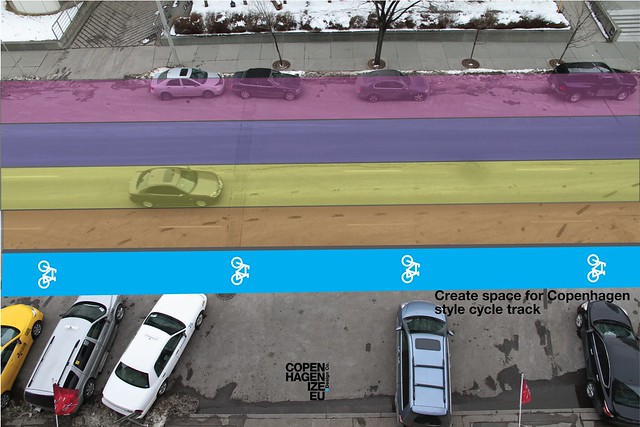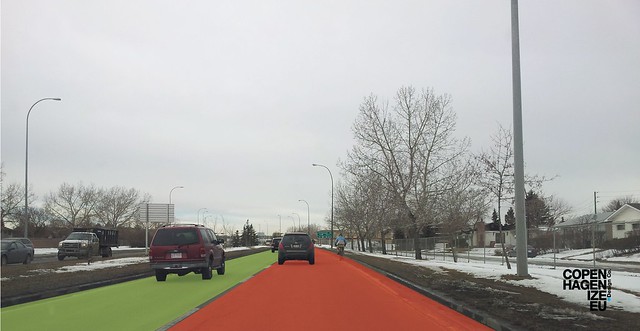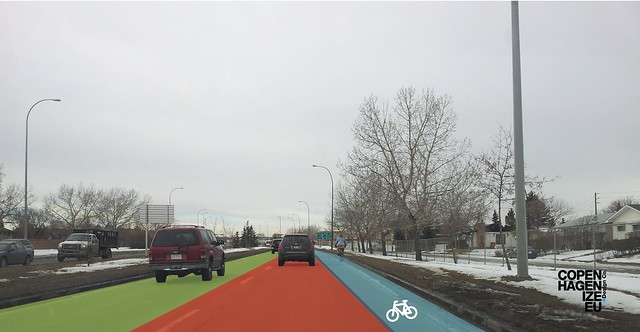
We have a tendency to give cities human character traits when we describe them. It's a friendly city. A dynamic city. A boring city. Perhaps then a city can be arrogant. Arrogant, for example, with it's distribution of space.
I've been working a lot in North America the past year and I've become quite obsessed with the obscenely unbalanced distribution of space. I see this arrogance everywhere I go. I see the insanely wide car lanes and the vehicles sailing back and forth in them like inebriated hippopotami. I was just in Calgary for five days and from my balcony at the hotel I watched the traffic below on 12th Ave. A one-way street that was never really busy at all.
From above, the arrogance of space was very apparent. Even more so than in a car driving down the lanes. The photo, above, is the car lines divided up with their actual width. Watching for five days - okay, not 24/7 ... I have a life after all - I didn't really see any vehicles that filled out the whole lane with their girth.
So, in a very unscientific way, I decided to take a bit of each lane away.

Narrowing the lanes slightly, space was created. Obviously. Duh. And there was still ample space for the vehicles - including the big trucks and SUVs.
We know that narrowing lane width improves safety. Just like tree-lined streets - or streets with utility poles, etc - make drivers slow down and concentrate, narrower travel lanes have the same positive effect. There were posters all around Calgary with the catchy headline "Crotches Kill". I can understand why texting is deemed easy when motorists are given so much space.
So, narrowing lane widths is safer. But what to do with that extra space?

On so many streets I've looked at in North American cities, even a two-lane street can cough up enough space for a Copenhagen-style cycle track.
Addendum: It's not possible to see it on these photos but the car parking at the bottom is an indentation in the curb in front of the hotel, so the cycle track runs along the curb, as it should.
I tire of hearing the incessant "we don't have space for bicycles" whine, especially in North American cities. The space is right there if you want it to be there. Removing car lanes to create cycle tracks is, of course, doable. So many cities are doing it. Not making cycle tracks for those who cycle now, but for the many who COULD be cycling if it was made safe.
However, when you live in an arrogant city, space is readily available. Often not even involving removing lanes or parking. It's right there. If you want it.

Another example from Calgary. Memorial Drive. A cyclist off to the right on this 60 km/h stretch. The motorist gave him a wide berth, exposing the arrogance of space for us.

Here's what could be possible.
I can hear the traffic engineers complaining already. This, of course, messes with every computer model they have. It's not, however, about them anymore. They've had their century of trial and error - mostly error. We're moving on now. We'll redesign our cities and tell them what to do and how to help us - based on human observation, rationality and logic. They're brilliant problem solvers. We'll just be telling them what problems to solve.
This quote by Andres Duany is appropriate:
"The problem with planning is that it has been overtaken by mathematical models - traffic, density, impact assessment, public costs etc. discarding common sense and empirical observation."

Ironically, I was reading a copy of The New Republic - found a copy at an airport - and saw the above snippet. The writer, one Tim Wu, clearly has time to ponder when he's sitting in traffic. He noticed the wide car lanes as well. His solution, however, was to promote narrower cars and increase the number of lanes - thereby creating "the first real drop in traffic congestion in decades", he claims. Note the tagline at the top right: "A more perfect world". This company is even producing narrower cars and their website makes the same claim: "This doubling of lane capacity can solve traffic congestion.
Unfortunately, the myth persists. The sum of our knowledge after 100 years of traffic engineering is that if you create more space for cars, more cars will come. Period. Again, time to move on. A more perfect world is within our reach, once we get a flock of misconception monkeys off our backs.

Another street, this one in Montreal. Wasted space on the right, arrogance of space on the left.
Take a look at the streets around you. This all applies to a great many of them. The space is right there for the taking.